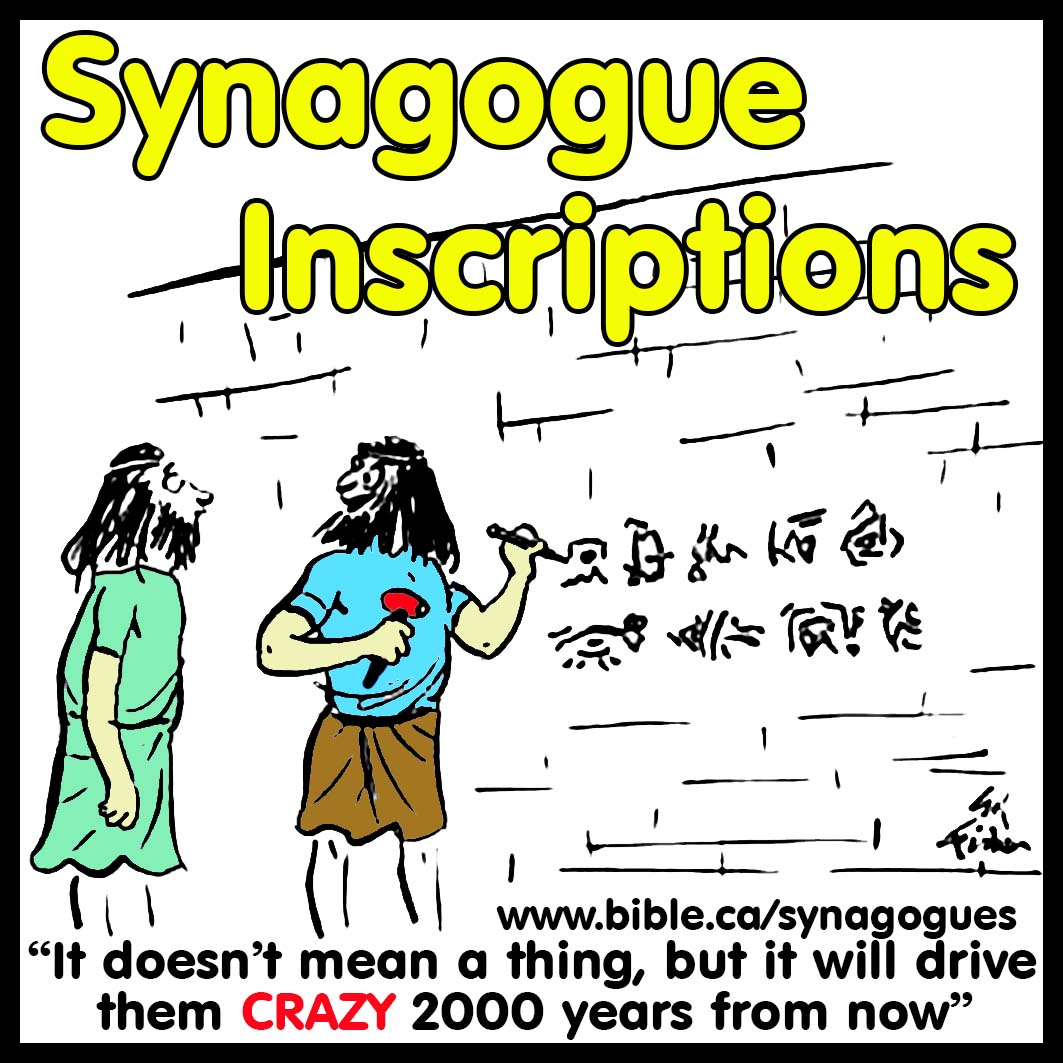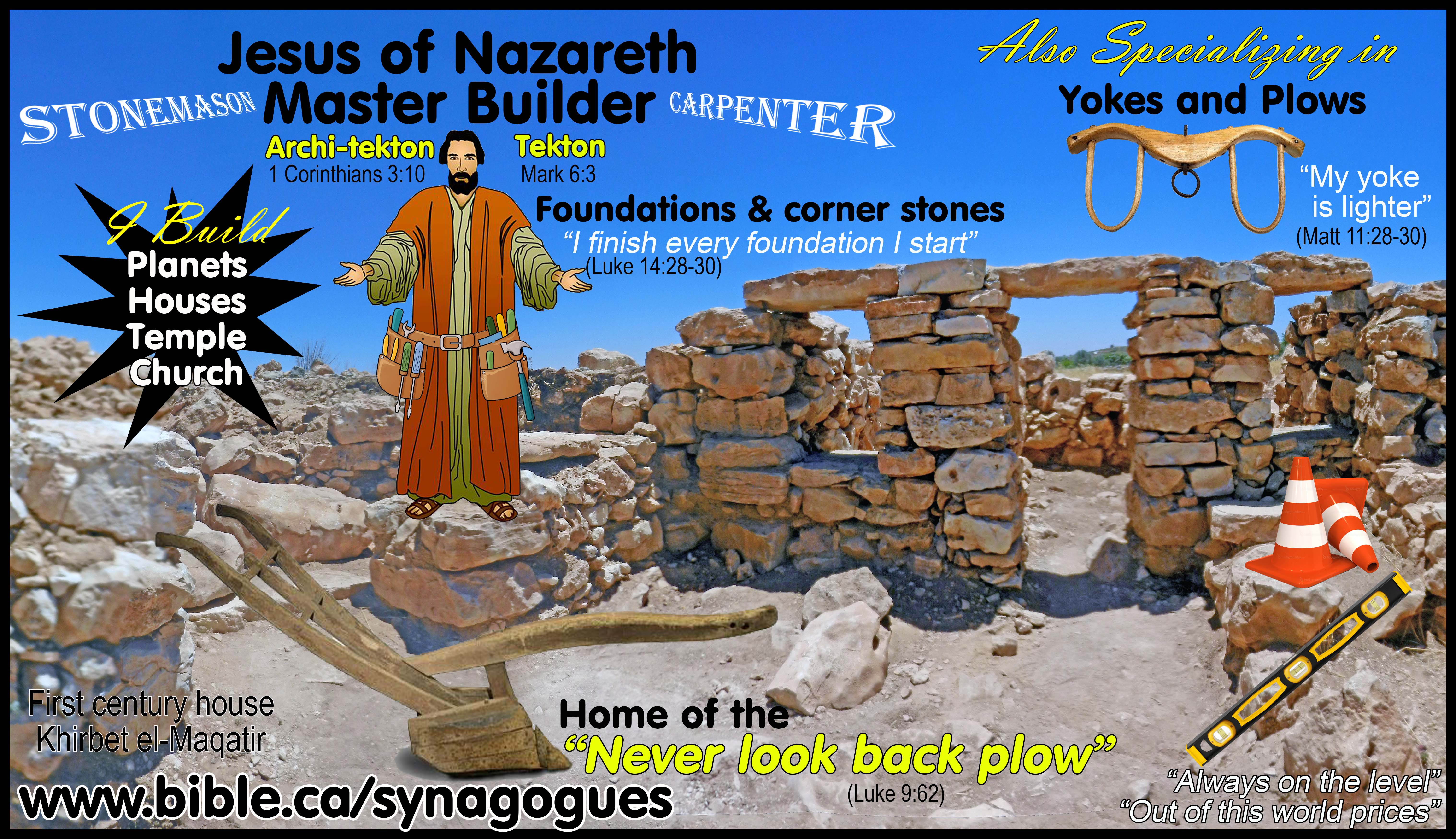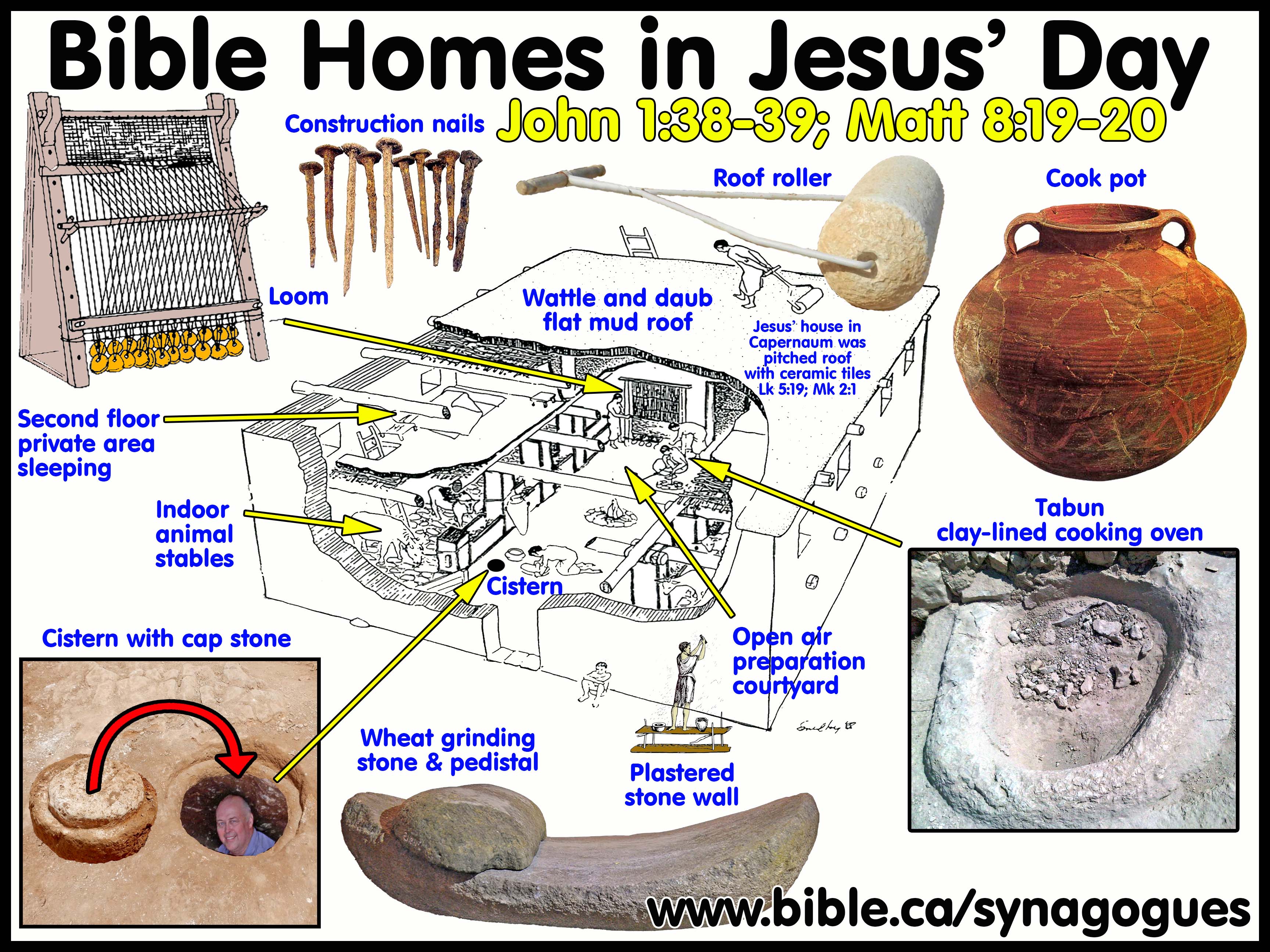Standardized Architectural Synagogue Signature Typology
Synagogue Architecture adopted by the Christian Church
Floorplans and Furnishings of Pre-70 AD Second Temple Period synagogues
“The scribes and the Pharisees have seated themselves in the chair of Moses;
therefore all that they tell you, do and observe, but do not do according to their deeds;
for they say things and do not do them." (Matthew 23:2-3)
“If a man comes into your assembly [Greek: synagogue]
with a gold ring and dressed in fine clothes,
and there also comes in a poor man in dirty clothes,
and you pay special attention to the one who is wearing the fine clothes, and say,
“You sit here in a good place,” and you say to the poor man,
“You stand over there, or sit down by my footstool” (James 2:1–6)
1. The earliest direct literary reference to the Synagogue “Seat of Moses” is in the Gospels:
a. “The scribes and the Pharisees have seated themselves in the chair of Moses; therefore all that they tell you, do and observe, but do not do according to their deeds; for they say things and do not do them." (Matthew 23:2-3)
2. Many other indirect references are made to the Moses’ seat and other special seating in synagogues:
a. “Woe to you Pharisees! For you love the chief seats in the synagogues and the respectful greetings in the market places." (Luke 11:43)
b. “Beware of the scribes, who like to walk around in long robes, and love respectful greetings in the market places, and chief seats in the synagogues and places of honor at banquets," (Luke 20:46)
c. “They love the place of honor at banquets and the chief seats in the synagogues" (Matthew 23:6)
d. "In His teaching He was saying: “Beware of the scribes who like to walk around in long robes, and like respectful greetings in the market places, and chief seats in the synagogues and places of honor at banquets, who devour widows’ houses, and for appearance’s sake offer long prayers; these will receive greater condemnation.”" (Mark 12:38-40)
3. Jesus was sitting on the MOSES SEAT OR the synagogue bench when he was handed a scroll and stood up to read it, then sat down again:
a. It is entirely possible that Jesus entered his home synagogue in Nazareth and “as His custom” sat in the Moses seat when it was his designated turn to read.
b. Perhaps they had a “Torah reading roster” like we do in our churches and that person sat in the “Moses seat”.
c. "When he came to Nazareth, where he had been brought up, he went to the synagogue on the sabbath day, as was his custom. He stood up to read," (Luke 4:16)
d. "And he rolled up the scroll, gave it back to the attendant, and sat down. The eyes of all in the synagogue were fixed on him." (Luke 4:20)
4. In 36 AD, James the Apostle condemned the idea of special seating in church assemblies for the rich vs. poor:
a. "My brethren, do not hold your faith in our glorious Lord Jesus Christ with an attitude of personal favoritism. For if a man comes into your assembly [Greek: synagogue] with a gold ring and dressed in fine clothes, and there also comes in a poor man in dirty clothes, and you pay special attention to the one who is wearing the fine clothes, and say, “You sit here in a good place,” and you say to the poor man, “You stand over there, or sit down by my footstool,” have you not made distinctions among yourselves, and become judges with evil motives? Listen, my beloved brethren: did not God choose the poor of this world to be rich in faith and heirs of the kingdom which He promised to those who love Him? But you have dishonored the poor man. Is it not the rich who oppress you and personally drag you into court?" (James 2:1–6)
b. It is important to keep in mind that providing a special place in a synagogue for the designated reader (Moses Seat) is different from rich vs. poor seating. Both rich and poor would take the Chair of Moses when it was their turn to read!
5. The Chair of Moses was reserved for the judge, synagogue leader, preacher, special guest etc:
a. “However, to the best of our knowledge and in contrast with the pagan priest and the Christian bishop, we know of no one particular person who might have regularly occupied such a seat in a synagogue setting, where leadership was relatively decentralized. Thus, it is likely that in many congregations more than one person occupied the cathedra, depending upon the particular activity then taking place: prayers, a sermon, a teaching session, court proceedings, visits by special guests, etc.” (The Synagogue in Late Antiquity, Lee Levine, p350, 1987 AD)
b. “Archaeological evidence from several sites points to the arrangement of special seats for synagogue leaders. In the Diaspora, the apse at the western end of the building at Sardis was clearly reserved for prominent members of the congregation, and such may also have been the case at Naro."4 An inscription on the side of the nave in the synagogue at Elche mentions elders and presbyters and seems to indicate the existence of such a bench for these leaders."' The last stages of the 1.1ammat Tiberias building (seventh to eighth centuries) also exhibit a bench in its apse that undoubtedly was reserved for congregational leaders." (The Synagogue in Late Antiquity, Lee Levine, p339, 1987 AD)
c. “Many explanations have been put forth in an attempt to explain the precise purpose of this cathedra, with each explanation finding its support in a particular source or a specific archaeological find. Roth and, more recently, Rahmani interpret the cathedra as the place where the Torah scroll was placed after it was read. Most scholars, however, view the cathedra as the seat for a leader in the congregation, although opinions differ as to the precise role of that leader: judge, archisynagogue, or spiritual-religious figure such as a Pharisee, sage, preacher, or some honored guest. In this context, it is worth noting the Samaritan account which speaks of a synagogue built by Baba Rabba at the foot of Mt. Gerizim; seven stones reputedly from the ancient Tabernacle were placed there, and on them sat seven members of the council.” (The Synagogue in Late Antiquity, Lee Levine, p350, 1987 AD)
6. Archeology of the Seat of Moses in Ancient Synagogues:
a. “CATHEDRA OF MOSES: One of the few furnishings found in synagogue excavations in both Palestine and the Diaspora is a seat reserved for an honored personage. This seat has been identified in several literary sources as the Cathedra or Seat of Moses. (The Synagogue in Late Antiquity, Lee Levine, p347, 1987 AD)
b. “The Seat of Moses: Among the furnishings of the synagogue was a stone seat mentioned in ancient literature as Cathedra d'Moshe = 'The Seat (Chair) of Moses'. Two types of seats were found in synagogue excavations (Hachlili 1988:193-4; 2008:37*-40*): (1) movable stone chairs and (2) built-in seats abutted to the Jerusalem-oriented wall next to the Torah Shrine. (1) Movable stone chairs were discovered in two synagogues in the Land of Israel—Korazim and Hammath Tiberias A, and one in the Diaspora, at the Delos synagogue. They were designated Cathedra d'Moshe, 'Seat of Moses' (Sukenik 1929; 1934:57-61; Renov 1955; Rahmani 1990; Mack 1994; Levine 2000:323, 327; Hachlili 1988:193-194; 1998:79-81). The Korazim 'Seat of Moses' (h-58, 1-74, w-57 cm.), carved from one block of basalt stone, was discovered by Ory in 1926 within the synagogue, "about 3 m north of the south-eastern corner, near the plastered wall" (Ory 1926a:7). The front of the seat was divided into three bands in which an Aramaic inscription was carved (Rahmani 1990:195-6, n. 24, Pls. 19-21A, B; Yeivin 2000: 54, 27*, 29*; May 2000:no. 71, Fig. 131, Pl. 26:1). The straight back of the seat is decorated with a carved four-petaled rosette within a circle, and on its front is a carved four-line Aramaic dedicatory inscription (Fig. IV-67). The chair has two decorated hand rails: remains of an eagle with spread wings and claws on the right hand-rail, and a less preserved representation of a lion's mane on the left hand-rail. May (2000:152, 156, no. 71) maintains that both hand-rails rendered eagles. The chair's rear is crudely carved, indicating that it stood attached to a wall. May and Stark (2002:242-243, Pls. 21-22) ascribed the carving of the chair and other carved basalt fragments to one artisan, Master G; from these basalt items they reconstructed the location of the 'Seat of Moses' in the synagogue hall in an elaborate symmetrical designed complex (Fig. 1V-32b), decorated with stone carved aediculae flanked by palm branches (no. 94, only one was discovered) placed on top of the imagined pillars and parts of a gable rendered with a lion (only one such fragment, no. 93, was found), at its ends. This reconstruction seems unlikely as the symmetry is entirely unproven, and no such complex is known elsewhere. (Ancient Synagogues - Archaeology and Art: New Discoveries and Current Research, Rachel Hachlili, p 219, 2013 AD)
7.
Delos Synagogue Moses’ Seat:

a. A marble chair and footstool were found in situ, flanked by a row of marble benches, along the northern half of the west wall of the Delos synagogue in room A, dated to the 1st century BCE (Goodenough 1958, III:Fig. 876; Bruneau 1970:492; Hachlili 1998:80-81, Fig. 11-35). White (1987:148) maintains that the benches and the precisely centered throne belong to the period of the renovation of Room A. Goodenough (1953, 11:71, note 9) compares the Delos synagogue chair with thrones found in Greek theaters at Athens and Tegea, and maintains it was a copy of a pagan throne, produced for Jewish use. Bruneau (1970:492) similarly compares the chair with the throne of Dionysus's priest found in the theater at Athens, dated to the first century BCE. Hengel (1974:note 160; 1975:37) suggests that the Delos chair was reserved for the leader of the service while those at Korazirn and Hammath Tiberias served the teachers. Rahmani (1990:203) maintains that the Delos arrangement "matches to a degree the description given of the seating customary in a contemporary Jewish court of law; the president sat in the center and the elders at his sides." The Delos chair was a prominent seat intended as a place for one of the synagogue dignitaries, like the theater chairs. (2) The other form of prominent seats found in synagogues is those built as part of the structure, abutted to the Jerusalem-oriented wall next to the Torah Shrine (Hachlili 1998:81).” (Ancient Synagogues - Archaeology and Art: New Discoveries and Current Research, Rachel Hachlili, p218, 2013 AD)
b. “May and Stark (2002:228, 242, P1. 22) on the other hand, reconstructed an elaborate decorated symmetrically-designed complex for the 'Seat of Moses' and interpret the word `stoa' in the inscription as alluding to the entire row of benches, suggesting that the 'Seat of Moses' complex stood in the center of the row of benches along the northern wall, on the axis of the Torah Shrine (Fig. IV-32b). ” (Ancient Synagogues - Archaeology and Art: New Discoveries and Current Research, Rachel Hachlili, p172, 2013 AD)
8.
Chorazin Synagogue Moses’ Seat:

a. Chorazim Moses’ Seat Inscription: “Remembered for good Judan son of Ishmael who made this MVO stoa and stairs. As his reward may he have a place with the righteous.” (Four line Aramaic inscription: 250 AD)
b. “The four-line Aramaic engraved dedicatory inscription on the Cathedra of Moses from Chorazim blesses the memory of "Judan son of Ishmael who made this MVO stoa and stairs" (Fig. XI-8). The term stoa is explained in various ways: Hiittenmeister (1977:280) and Rahmani (1990:195) explain the term as referring to the chair itself and the stairs leading up to it. Yeivin (1985:274275; 2000:29*, plan 14, following Epstein; also Naveh 1989:306) is probably correct in suggesting that the seat is associated with the Korazim eastern iztaba—the raised platform constructed on the inner southern Jerusalem-oriented wall that was used for reading the Torah (Fig. IV-31).7 The chair's date is in dispute: some attribute it to the mid or late 3rd century CE, others to the 5th century CE (Sukenik 1929; Rahmani 1990:195-6, Pls. 19-21A; Yeivin 2000:54, 22-23*, Fig. 130, Pl. 26, 1, no. 71; May 2000:152, 156, no. 71). A comparable basalt chair was uncovered in Suweida in Syria; its hand-rails are formed as two crouching lions, now broken, one holding a ram between his paws and the other a goat (Dunand 1934:16, P1.7, no. 5; Rahmani 1990:196, Pl. 21c). Another basalt fragment found in Raha consists of a seated figure flanked by two lions (Dunand 1934:81, Pl. 34, no. 169; see also a small stone chair with sphinxes as side supports [Seyrig 1959:48-52, P1.10:3, 5]). The stone chair of Korazim with its animal hand-rails could be compared to the biblical description of the elaborate throne of Solomon (I Kings 10:18-20; Chronicles 9, 17-19), that is described as a great ivory throne overlaid with pure gold, with two flanking lions as side-supports and a dais of six steps with twelve standing lions, one at each end of each step.8 The throne of King Solomon is depicted on the wall paintings (Panel WA2) of the mid-third century CE Dura Europos synagogue. A similar throne, also found there, on which Ahasuerus is seated, is painted on panel WC2 (Kraeling 1979:89-90, 158, Pls. 65, 28; Hachlili 1998:166-168, Fig. 111-45). Similar renditions of thrones flanked by lions appear in paintings and sculptures from other second and third century CE buildings at Dura Europos and Palmyra (Hachlili 1998:167-8). Hence, it is possible that the stone chair of Korazim reflected the notion of an ancient throne. (Ancient Synagogues - Archaeology and Art: New Discoveries and Current Research, Rachel Hachlili, p218, 2013 AD)
c. “The location of the 'Seat of Moses' at Korazim should be considered in relation to its function. If it was used for reading the Torah, as Yeivin argues, or only for holding the Torah scroll, as Rahmani suggests, the placement of the seat in the second aedicula is acceptable. If, however, the chair was meant for an elder, a preacher, or any other community figure, than it might have been located among the row of benches, as May and Stark had proposed. ” (Ancient Synagogues - Archaeology and Art: New Discoveries and Current Research, Rachel Hachlili, p 219, 2013 AD)
9.
Hammath-Tiberias Synagogue Moses’ Seat:

a. “The limestone chair found in the synagogue of Hammath Tiberias A has survived only as a drawing (Fig. W-68); the available data includes the measurements (height of back-94 cm.; height of support-40 cm.; width of seat-60 cm.; height of seat-55 cm.). The chair has a straight back, no hand rails, and three holes in a row on the seating surface (Slouschz 1921:30, 38, Fig. 15; Vincent 1922:117, Fig. 6; Sukenik 1929; 1934:61, Fig. 19). Although the original location of the chair is not clear, Rahmani (1990:193-4) proposes that it probably stood with its back to the southern Jerusalem-oriented wall, parallel to the Torah Shrine, to the left of a large niche on its eastern side. The chair possibly dates to the 4th century CE. (Ancient Synagogues - Archaeology and Art: New Discoveries and Current Research, Rachel Hachlili, p218, 2013 AD)
10.
Ein Gedi Seat of Moses with footstool:

a. “At the 'En Gedi synagogue, a two-stepped plaster-covered seat was constructed next to the niche at the northeastern corner." (Barag 2006:17*). (Ancient Synagogues - Archaeology and Art: New Discoveries and Current Research, Rachel Hachlili, p218, 2013 AD)
11. Dura-Europos seat of Moses: “At Dura-Europos a plaster-covered bench is built on the west wall, abutting the north side of the niche and forming a raised seat with five steps. Kraeling (1979:17, 260, Pls. V, XXV) maintains it served as a Seat of the Elders, and that Samuel the Elder, the builder of the synagogue, sat on this raised seat beside the Torah Shrine, whereas Rostovtzeff (1938:106) considered the seat to be reserved for the Cohen. ” (Ancient Synagogues - Archaeology and Art: New Discoveries and Current Research, Rachel Hachlili, p218, 2013 AD)
12. The early church violated Jesus prohibition of special seating through the clergy-laity distinction.
a. Byzantine Christians went beyond the first century Jews by creating special areas
b. “Special cathedra-like seats are known from pagan and Christian contexts as well, and the Jews thus appear to have adopted this practice from their surroundings, using it for any or all of the above-noted purposes. Pagan priests often sat on cathedrae in their temples, and bishops and other clergy sat on special seats in their churches.” (The Synagogue in Late Antiquity, Lee Levine, p350, 1987 AD)
c. By 250 AD, the church had departed from a simple plurality of qualified congregational overseers to a new unbiblical system where one man is not only over one congregation, but where he functions as a “diocesan bishop” over many congregations.
d. See the “mouse rollover” of the graduation of organizational apostacy, 150 - 381 AD
13. Special seating is based upon function not material wealth, fame or status:
a. Nehemiah stood on a special elevated platform the same way preachers do today at the pulpit as a kind of special area.
b. Often in our churches, the front pews are designated for special people participating in readings, leading singing or presiding over the Lord’s supper.
c. Churches today, therefore have a “kind of” Chair of Moses, as in a special seat.
d. The church needs to guard against the clergy-laity division.
e. As noted, women were NOT segregated from the men in early synagogues and churches, and for good reason: Segregation of women becomes a sinful prohibited distinction: Gal 3:27-28. While women can and do sit anywhere in the congregation, the New Testament prohibits them from preaching or taking leadership roles: 1 Timothy 2:11-12
f. Any special seating or standing places MUST be open to any male member of the local congregation regardless of material wealth or fame.
14. The error of the church therefore, was not in providing special seating, but in creating a special class and rank distinction in the general membership that not does not exist in the bible, and violated the ancient synagogue tradition of a “general community of equal believers”.
a. The New testament authorizes a rank class distinction between overseers and the rest of the congregation which they shepherd.
b. Creating functional distinctions and barriers like preaching, leading communion etc. between Elders/overseers/Shepherds and the general congregation is sinful and a violation of the New Testament pattern and ancient synagogue tradition.
15. The Chair of Moses replaced by the Throne of Christ: Deut 18:18-19
a. "‘I will raise up a prophet from among their countrymen like you, and I will put My words in his mouth, and he shall speak to them all that I command him. ‘It shall come about that whoever will not listen to My words which he shall speak in My name, I Myself will require it of him." (Deuteronomy 18:18–19)
b. Moses clearly said that when the Messiah comes, that he would relinquish his authority to the Messiah and commanded all his followers to obey Christ in all things.
c. "But of the Son [Jesus] He [Father] says, “YOUR THRONE, O GOD, IS FOREVER AND EVER, AND THE RIGHTEOUS SCEPTER IS THE SCEPTER OF HIS KINGDOM. “YOU HAVE LOVED RIGHTEOUSNESS AND HATED LAWLESSNESS; THEREFORE GOD, YOUR GOD, HAS ANOINTED YOU WITH THE OIL OF GLADNESS ABOVE YOUR COMPANIONS.” And, “YOU, LORD, IN THE BEGINNING LAID THE FOUNDATION OF THE EARTH, AND THE HEAVENS ARE THE WORKS OF YOUR HANDS; THEY WILL PERISH, BUT YOU REMAIN; AND THEY ALL WILL BECOME OLD LIKE A GARMENT, AND LIKE A MANTLE YOU WILL ROLL THEM UP; LIKE A GARMENT THEY WILL ALSO BE CHANGED. BUT YOU ARE THE SAME, AND YOUR YEARS WILL NOT COME TO AN END.”" (Hebrews 1:8–12)
d. "For this reason also, God highly exalted Him, and bestowed on Him the name which is above every name, so that at the name of Jesus EVERY KNEE WILL BOW, of those who are in heaven and on earth and under the earth, and that every tongue will confess that Jesus Christ is Lord, to the glory of God the Father." (Philippians 2:9–11)
e. Ancient
papyrus documents found at Qum’ran
quote Deut 18:18 in expectation of the Messiah.

By Steve Rudd 2017: Contact the author for comments, input or corrections
|
Jesus your messiah is waiting for you to come home! |
|
|
Why not worship with a first century New Testament church near you, that has the same look and feel as the Jewish Synagogue in your own home town. As a Jew, you will find the transition as easy today as it was for the tens of thousands of your forefathers living in Jerusalem 2000 years ago when they believed in Jesus the Nazarene (the branch) as their messiah. It’s time to come home! |
|
By Steve Rudd: Contact the author for comments, input or corrections.
Go to: Main Ancient Synagogue Start Page










